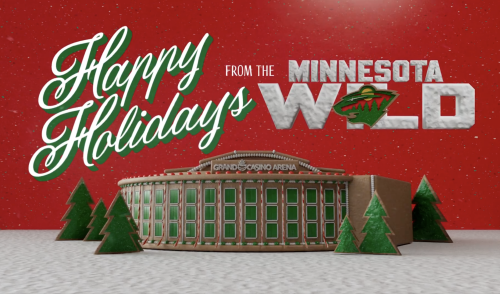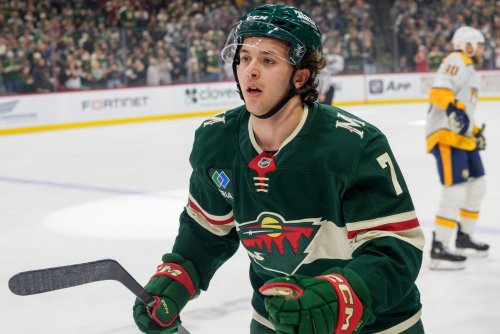
The Minnesota Wild's season is over, and the State of Hockey can finally turn its attention to the summer. We discovered that the Wild will pick 13th in the 2024 Draft, barring a 4.2% chance of winning the lottery. The 13th pick isn't much consolation after missing the playoffs. Still, this is their third-highest draft position since picking Matt Dumba 7th overall in 2012.
The Wild picked at No. 9 once (Marco Rossi) in 2020, when the Wild dropped into the top 10 after weird circumstances bumped Minnesota into the thick of the Draft Lottery. The other high-ish pick they've had in the last dozen seasons was in 2019, following their only other playoff miss over that span. They snagged franchise building block Matt Boldy.
It's no secret that the Wild have built up an arsenal of young talent, with Boldy, Rossi, and Brock Faber already dazzling in the NHL and more impact prospects on the way. Their stockpile of young players will be expected to help them compete in the 2025-26 season, right as the worst of the Zach Parise and Ryan Suter buyout penalties expire.
If all goes well, that season should kick off Minnesota's contention window. Will that No. 13 overall draft pick be a factor, then? The Wild need to consider this question as they weigh their options for the draft.
Draft picks aren't just potential NHLers. They're the NHL's legal tender, able to be swapped for sweet, sweet, NHL-ready assets. The Wild have almost exclusively been on the "Buyer" side for draft picks, at least their most important ones. Minnesota has made at least three selections in the first two rounds in the last five drafts. The only major pick they've surrendered was one of their three second-rounders in the 2022 Draft via the Marc-Andre Fleury trade.
Hoarding top picks like toilet paper in March 2020 was a welcome change for Wild fans who'd seen their favorite team draft in the first two rounds just six times in six years (2013 to 2018). There might even be justifiable hesitation going back to the direction of selling draft picks.
The pendulum will have to swing back there eventually. Why not start this summer? They might have had a dreadful season, and their dead cap woes will continue one more year, but they have compelling reasons not to simply take a knee next season.
Most importantly, they have to make a pitch to convince Kirill Kaprizov to stay long-term. With 33 goals and 60 points over his final 37 games, Kaprizov showed he's capable of an MVP-caliber performance. They can't lose a player like that, and not trying to compete next year is, at the very least, not making Minnesota's best pitch to their superstar.
They may also have the horses to get them to the postseason, even with their dead cap hit. Sportlogiq's expected goals data suggests Minnesota could've comfortably finished in a Wild Card spot with neutral goaltending. If the Wild can fix that (and since goaltending is voodoo, that's hard to predict), they have a playoff team, and adding NHL-ready talent can only increase their margin for error.
What's the likelihood that their first-round pick can do that next year? Or even the year after that?
Surprisingly, we've seen some prospects get on the fast track from the 13th overall pick to the NHL. Let's look at those picks from the last five drafts and see how long it took for them to make the NHL full-time.
2023, Zach Benson, Buffalo Sabres: 71 Games Played in (Draft+1 season)
2022, Frank Nazar, Chicago Blackhawks: Expected to play in Draft+3 season
2021, Matthew Coronato, Calgary Flames: 33 GP in 2023-24 (Draft+3 season)
2020, Seth Jarvis, Carolina Hurricanes: 68 GP in 2021-22 (Draft+2 season)
2019, Spencer Knight, Florida Panthers: 32 GP in 2021-22 (Draft+3 season)
Benson and Jarvis represent the ideal timetable for the Wild to make an impact. If Minnesota gets a player like Benson, whom they determine is ready to go, the wait for contributions doesn't matter. If they have someone with Jarvis' timetable, they only need to wait until the 2025-26 season, which perfectly matches Minnesota's timetable.
If that player turns out to be on the timetable of Nazar, Coronato, or Knight, though? That complicates matters. We also have to consider more than just games -- did Benson or Jarvis make an immediate impact?
Jarvis indisputably did, scoring 40 points in 68 games and delivering the Hurricanes 4.2 Standings Points Above Replacement in his rookie season. But Benson scored just 30 points in his 71 games, earning his team just 0.4 SPAR. That's not bad, but it's not a great case that Minnesota will get an immediate impact from their pick next year.
You can't solely rely on the past for guidance, though. There may be a Benson or Jarvis up for grabs for Minnesota, and there might not be. It depends on the caliber of player that falls into the Wild's range.
Draft boards will change, and opinions will vary from team to team and person to person. But let's check out the draft board The Athletic's Corey Pronman recently released. At the 13th spot in his rankings, there are still three players from his "Top of the lineup player" tier of prospect: defenseman Adam Jiricek, winger Cole Eiserman, and center Tij Iginla.
Draft time is ready-made for hyperbole. Everyone in Minnesota loves Jonas Brodin. But people compared him to Nicklas Lidstrom when the Wild drafted him, and Brodin didn't become the best defenseman of all time. Pronman's scouting reports are particularly useful because he seeks to avoid hyperbole when comparing prospects to NHLers.
The realistic outcomes Pronman envisions for those three prospects are, respectively, Vladislav Gavrikov, Owen Tippett, and John-Jason Peterka. Are those all good players? Sure. Gavrikov gave the Los Angeles Kings 20-plus minutes a night on the blue line, and Tippett and Peterka scored 28 goals and hit the 50-point mark this season.
But they didn't do it right away. Gavrikov took the long way to the NHL as a sixth-round pick in 2015. He didn't make the NHL until his age-24 season -- although playing in the KHL may have been a factor.
The Florida Panthers drafted Tippett No. 10 overall in 2017 and didn't make the NHL full-time until 2020-21, his Draft+4 season. Even then, it took two years and a change of scenery for Tippett to unlock his potential.
Peterka was faster to becoming an NHL regular than those two. The Buffalo Bills drafted him in 2020 (No. 34 overall) and debuted full-time in the 2022-23 season (Draft+3). He made a minimal impact as a rookie, though, only truly breaking out this season.
None of this means that these players can't beat their comparisons' timetables. It also doesn't mean higher-rated, more NHL-ready players can't fall to Minnesota. But what's more likely to happen: The No. 13 pick delivering relatively immediate impact or the Wild being able to turn that pick into a player that pushes the needle?
Minnesota has to be careful to make the money work, targeting a player with at least one cheap year left on their deal before needing a raise. But if they can find such a player, their pick should have value.
In 2018, the Calgary Flames turned their 12th overall selection into first-pair defenseman Travis Hamonic. The Ottawa Senators acquired Alex DeBrincat by packaging their 7th overall pick to the Chicago Blackhawks in 2021. Six picks later, the Montreal Canadiens acquired Kirby Dach with Minnesota's exact draft position.
If Minnesota wants an avenue to fix their secondary scoring or blue line, they don't need to trade a roster player like Rossi. They don't have to sacrifice a top prospect knocking on the NHL's door, like Liam Öhgren or Danila Yurov. They have a good lottery ticket at No. 13 overall, but it's exchangeable for a player who pushes up their contention window and keeps Kaprizov happy. Why not cash it in now?
Think you could write a story like this? Hockey Wilderness wants you to develop your voice, find an audience, and we'll pay you to do it. Just fill out this form.








Recommended Comments
Join the conversation
You can post now and register later. If you have an account, sign in now to post with your account.
Note: Your post will require moderator approval before it will be visible.